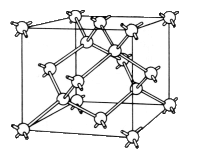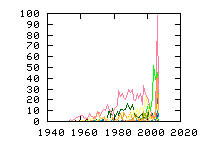« Previous
1
Next »
(11 hits, 1/1)
Showing
10, 25, 50, 100, 500, 1000, all papers per page.
Sort by:
last publication date,
older publication date,
last update date.
- 1. Phys. Rev. B 75, 075420 (2007) , “Ab initio study of hydrogen interaction with pure and nitrogen-doped carbon nanotubes”, Zhiyong Zhang and Kyeongjae ChoDetailed studies of mechanisms for hydrogen dissociative adsorption and diffusion on pure and nitrogen-doped (8, 0) carbon nanotubes are carried out using the first-principles density functional theory method. (1) For pure carbon nanotubes, we have identified the energetically most favorable... (Read more)
- 2. Phys. Rev. B 75, 073409 (2007) , “Why thermal H2 molecules adsorb on SiC(001)-c(4×2) and not on SiC(001)-(3×2) at room temperature”, Xiangyang Peng, Peter Krüger, and Johannes PollmannIn a recent experiment, Derycke et al. have made the exciting observation that H2 molecules readily adsorb dissociatively on the c(4×2) but not on the 3×2 surface of SiC(001) at room temperature. To unravel this spectacular reactivity difference, we have investigated a... (Read more)
- 3. Phys. Rev. B 75, 035309 (2007) , “Role of hydrogen in hydrogen-induced layer exfoliation of germanium”, J. M. Zahler, A. Fontcuberta i Morral, M. J. Griggs, Harry A. Atwater, and Y. J. ChabalThe role of hydrogen in the exfoliation of Ge is studied using cross-sectional transmission electron microscopy, atomic force microscopy, and multiple-internal transmission mode Fourier-transform infrared absorption spectroscopy and compared with the mechanism in silicon. A qualitative model for the... (Read more)
- 4. Phys. Rev. Lett. 98, 215503 (2007) , “Nature of the Bound States of Molecular Hydrogen in Carbon Nanohorns”, F. Fernandez-Alonso, F. J. Bermejo, C. Cabrillo, R. O. Loutfy, V. Leon, and M. L. SaboungiThe effects of confining molecular hydrogen within carbon nanohorns are studied via high-resolution quasielastic and inelastic neutron spectroscopies. Both sets of data are remarkably different from those obtained in bulk samples in the liquid and crystalline states. At temperatures where bulk... (Read more)
- 5. Phys. Rev. Lett. 98, 055504 (2007) , “Ortho-Para Conversion of Interstitial H2 in Si”, M. Hiller, E. V. Lavrov, and J. WeberOrtho-para conversion of isolated interstitial H2 in single-crystalline Si is studied by Raman scattering. This process is suggested to be caused by the interaction of H2 with the nuclear magnetic moment of 29Si. At 77 K the ortho-to-para conversion rate is... (Read more)
- 6. Appl. Phys. Lett. 89, 211914 (2006) , “Molecular hydrogen formation in hydrogenated silicon nitride”, H. F. W. Dekkers, G. Beaucarne, M. Hiller, H. Charifi, and A. SlaouiHydrogen is released from hydrogenated silicon nitride (SiNx:H) during thermal treatments. The formation of molecular hydrogen (H2) in SiNx:H layers with low mass density is confirmed by Raman spectroscopy. However, no H2 is observed in... (Read more)
- 7. Phys. Rev. B 74, 235214 (2006) , “Raman scattering study of H2 in Si”, M. Hiller, E. V. Lavrov, and J. WeberIsolated interstitial H2 and H2 bound to interstitial oxygen (O–H2) in single-crystalline Si are studied by Raman scattering. Two Raman signals at 3199(1) and 3193(1) cm−1 (T0 K) are identified as ro-vibrational transitions of... (Read more)
- 8. Phys. Rev. B 74, 193405 (2006) , “Role of charge in destabilizing AlH4 and BH4 complex anions for hydrogen storage applications: Ab initio density functional calculations”, A. J. Du, Sean C. Smith, and G. Q. LuNaAlH4 and LiBH4 are potential candidate materials for mobile hydrogen storage applications, yet they have the drawback of being highly stable and desorbing hydrogen only at elevated temperatures. In this letter, ab initio density functional theory calculations reveal... (Read more)
- 9. Microelectron. Reliability 45, 71 (2005) , “A comprehensive model of PMOS NBTI degradation ”,Negative bias temperature instability has become an important reliability concern for ultra-scaled Silicon IC technology with significant implications for both analog and digital circuit design. In this paper, we construct a comprehensive model for NBTI phenomena within the framework of the standard reaction–diffusion model. We demonstrate how to solve the reaction–diffusion equations in a way that emphasizes the physical aspects of the degradation process and allows easy generalization of the existing work. We also augment this basic reaction–diffusion model by including the temperature and field-dependence of the NBTI phenomena so that reliability projections can be made under arbitrary circuit operating conditions. (Read more)
- 10. J. Appl. Phys. 94, 1 (2003) , “Negative bias temperature instability: Road to cross in deep submicron silicon semiconductor manufacturing”,We present an overview of negative bias temperature instability (NBTI) commonly observed in p-channel metal–oxide–semiconductor field-effect transistors when stressed with negative gate voltages at elevated temperatures. We discuss the results of such stress on device and circuit... (Read more)
- 11. Phys. Rev. B 39, 10791-10808 (1989) , “Theory of hydrogen diffusion and reactions in crystalline silicon”, Chris G. Van de Walle, P. J. H. Denteneer, Y. Bar-Yam, and S. T. PantelidesThe behavior of hydrogen in crystalline silicon is examined with state-of-the-art theoretical techniques, based on the pseudopotential-density-functional method in a supercell geometry. Stable sites, migration paths, and barriers for different charge states are explored and displayed in total-energy... (Read more)
« Previous
1
Next »
(11 hits, 1/1)
Showing
10, 25, 50, 100, 500, 1000, all papers per page.
Sort by:
last publication date,
older publication date,
last update date.
All papers (3399)
Updated at 2010-07-20 16:50:39
Updated at 2010-07-20 16:50:39
(view as: tree
,
cloud
)
| 1329 | untagged |
Materials
(111 tags)
Others(101 tags)
Technique
(46 tags)
Details
(591 tags)
Bond(35 tags)
Defect(interstitial)(18 tags)
Defect(vacancy)(15 tags)
Defect-type(19 tags)
Element(65 tags)
Energy(8 tags)
Isotope(56 tags)
Label(303 tags)
Sample(17 tags)
Spin(8 tags)
Symmetry(15 tags)

